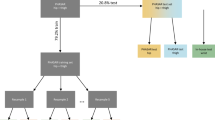Abstract
As health studies increasingly monitor free-living heart performance via ECG patches with accelerometers, researchers will seek to investigate cardio-electrical responses to physical activity and sedentary behavior, increasing demand for fast, scalable methods to process accelerometer data. We extend a posture classification algorithm for accelerometers in ECG patches when researchers do not have ground-truth labels or other reference measurements (i.e., upright measurement). Men living with and without HIV in the Multicenter AIDS Cohort study wore the Zio XT® for up to 2 weeks (n = 1250). Our novel extensions for posture classification include (1) estimation of an upright posture for each individual without a reference upright measurement; (2) correction of the upright estimate for device removal and re-positioning using novel spherical change point detection; and (3) classification of upright and recumbent periods using a clustering and voting process rather than a simple inclination threshold used in other algorithms. As no posture labels exist in the free-living environment, we perform numerous sensitivity analyses and evaluate the algorithm against labeled data from the Towson Accelerometer Study, where participants wore accelerometers at the waist. On average, 87.1% of participants were recumbent at 4 a.m. and 15.5% were recumbent at 1 p.m. Participants were recumbent 54 min longer on weekends compared to weekdays. Performance was good in comparison to labeled data in a separate, controlled setting (accuracy = 96.0%, sensitivity = 97.5%, specificity = 95.9%). Posture may be classified in the free-living environment from accelerometers in ECG patches even without measuring a standard upright position. Furthermore, algorithms that fail to account for individuals who rotate and re-attach the accelerometer may fail in the free-living environment.





Similar content being viewed by others
References
Deyell M, Krahn A, Goldberger J (2015) Sudden cardiac death risk stratification. Circ Res 116(12):1907–1918. https://doi.org/10.1161/CIRCRESAHA.116.304493
Heravi A, Etzkorn L, Urbanek J et al (2020) HIV infection is associated with variability in ventricular repolarization: the multicenter AIDS cohort study (MACS). Circulation 141(3):176–187
Yeragani VK, Pohl R, Jampala VC, Balon R, Kay J, Igel G (2000) Effect of posture and isoproterenol on beat-to-beat heart rate and QT variability. Neuropsychobiology 41(3):113. https://doi.org/10.1159/000026642
Hansson G, Asterland P, Holmer N, Skerfving S (2001) Validity and reliability of triaxial accelerometers for inclinometry in posture analysis. Med Biol Eng Comput 39(4):405–413. https://doi.org/10.1007/BF02345361
Gupta R, Gupta A, Aswal R (2021) Detection of poor posture using wearable sensors and unsupervised learning. In: 7th international conference on advanced computing and communication systems, vol 1, pp 527–531
Grant PM, Ryan CG, Tigbe WW, Granat MH (2006) The validation of a novel activity monitor in the measurement of posture and motion during everyday activities. Br J Sports Med 40(12):992–997
Lyons GM, Culhane KM, Hilton D, Grace PA, Lyons D (2005) A description of an accelerometer-based mobility monitoring technique. Med Eng Phys 27(6):497–504
Fortune E, Lugade VA, Kaufman KR (2014) Posture and movement classification: the comparison of tri-axial accelerometer numbers and anatomical placement. J Biomech Eng 136(5):051003
Lugade V, Fortune E, Morrow M, Kaufman K (2014) Validity of using tri-axial accelerometers to measure human movement—Part I: posture and movement detection. Med Eng Phys 36(2):169–176
Yoon H, Hwang S, Jung D, Choi S, Joo K, Choi J, Lee Y, Jeong DU, Park K (2015) Estimation of sleep posture using a patch-type accelerometer based device. In: 37th annual international conference of the IEEE Engineering in Medicine and Biology Society (EMBC), pp 4942–4945.
Smits EJ, Salomoni S, Costa N, Rodríguez-Romero B, Hodges PW (2022) How reliable is measurement of posture during sleep: real-world measurement of body posture and movement during sleep using accelerometers. Physiol Measur 43(1).
Vähä-Ypyä H, Husu P, Suni J, Vasankari T, Sievänen H (2018) Reliable recognition of lying, sitting, and standing with a hip-worn accelerometer. Scand J Med Sci Sports 28(3):1092–1102. https://doi.org/10.1111/sms.13017
How does the ActiGraph device determine inclination (for waist wear locations)? Actigraph Support Center Web site. Updated 2018. https://actigraphcorp.force.com/support/s/article/How-Does-The-ActiGraph-Device-Determine-Inclination-for-Waist-Wear-Locations. Accessed 17 Jul 2019.
Narayanan A, Desai F, Stewart T, Duncan S, Mackay L (2020) Application of raw accelerometer data and machine-learning techniques to characterize human movement behavior: a systematic scoping review. J Phys Act Health 17(3):360–383
Griffiths B, Diment L, Granat MH (2021) A machine learning classification model for monitoring the daily physical behaviour of lower-limb amputees. Sensors 21(22):7458
Greenwood-Hickman MA, Nakandala S, Jankowska MM, Rosenberg D, Tuz-Zahra F, Bellettiere J, Carlson J, Hibbing PR, Zou J, Lacroix AZ, Kumar A (2021) The CNN Hip Accelerometer Posture (CHAP) method for classifying sitting patterns from hip accelerometers: a validation study. Med Sci Sports Exerc
Rowlands AV, Yates T, Olds TS, Davies M, Khunti K, Edwardson CL (2016) Sedentary sphere: wrist-worn accelerometer-brand independent posture classification. Med Sci Sports Exerc 48(4):748–754
Tang Q, John D, Thapa-Chhetry B, Arguello DJ, Intille S (2020) Posture and physical activity detection: impact of number of sensors and feature type. Med Sci Sports Exerc 52(8):1834
Garcia-Ceja E, Brena RF (2018) An improved three-stage classifier for activity recognition. Int J Pattern Recognit Artif Intell 32(01):1860003
Lee MW, Khan AM, Kim TS (2011) A single tri-axial accelerometer-based real-time personal life log system capable of human activity recognition and exercise information generation. Pers Ubiquit Comput 15(8):887–898
iRhythm Technologies Inc. Zio XT prep and application video. Vimeo Web site. Updated June 23, 2021. https://vimeo.com/566778685. Accessed 30 Sept 2022
Chen J, Gupta AK (2013) Parametric statistical change point analysis. Birkhäuser, Boston
Mardia KV and Jupp PE (2000) Directional statistics. Wiley, Chichester.
Truong C, Oudre L, Vayatis N (2020) Selective review of offline change point detection methods. Signal Process 167:107299. https://doi.org/10.1016/j.sigpro.2019.107299
Cheng Y (1995) Mean shift, mode seeking, and clustering. TPAMI. 17(8):790–799
Lisic J (2021) meanShiftR, A computationally efficient mean shift implementation. 0.56.
Wrzus C, Brandmaier AM, Von Oertzen T, Müller V, Wagner GG, Riediger M (2012) A new approach for assessing sleep duration and postures from ambulatory accelerometry. PLoS ONE 7(10).
Acknowledgements
Work for this manuscript was supported by Grants 5T32AG000247 from the National Institute on Aging; 5R01HL125053 from the National Heart, Lung, and Blood Institute; and 5R01NS060910 from the National Institute of Neurological Disorders and Stroke. We appreciate the valuable contributions of MACS investigators, staff, and participants. Data were collected by the Multicenter AIDS Cohort Study (MACS). MACS (Principal Investigators): Johns Hopkins University Bloomberg School of Public Health (Joseph Margolick, Todd Brown), U01-AI35042; Northwestern University (Steven Wolinsky), U01-AI35039; University of California, Los Angeles (Roger Detels, Otoniel Martinez-Maza), U01-AI35040; University of Pittsburgh (Charles Rinaldo, Jeremy Martinson), U01-AI35041; the Center for Analysis and Management of MACS, Johns Hopkins University Bloomberg School of Public Health (Lisa Jacobson, Gypsyamber D’Souza), UM1-AI35043. The MACS is funded primarily by the National Institute of Allergy and Infectious Diseases (NIAID), with additional co-funding from the National Cancer Institute (NCI), the National Institute on Drug Abuse (NIDA), and the National Institute of Mental Health (NIMH). Targeted supplemental funding for specific projects was also provided by the National Heart, Lung, and Blood Institute (NHLBI), and the National Institute on Deafness and Communication Disorders (NIDCD). MACS data collection is also supported by UL1-TR001079 (JHU ICTR) from the National Center for Advancing Translational Sciences (NCATS) a component of the National Institutes of Health (NIH), and NIH Roadmap for Medical Research. Dr. Ashikaga receives research funding from The Foundation Leducq Transatlantic Network of Excellence (16CVD02). The contents of this publication are solely the responsibility of the authors and do not represent the official views of the National Institutes of Health (NIH), Johns Hopkins ICTR, or NCATS. The MACS website is located at http://aidscohortstudy.org/.
Funding
Funding was provided by National Institute on Aging (5T32AG000247), National Heart, Lung, and Blood Institute (5R01HL125053), and National Institute of Neurological Disorders and Stroke (5R01NS060910).
Author information
Authors and Affiliations
Corresponding author
Ethics declarations
Conflict of interest
The results of the study are presented clearly, honestly, and without fabrication, falsification, or inappropriate data manipulation. Drs. Etzkorn, Heravi, Knuth, Wu, and Post report no conflicts of interest with the present work. Dr. Ciprian Crainiceanu is consulting for Bayer, Johnson and Johnson, and Cytel on methods development for wearable and implantable technologies. The details of these contracts are disclosed through the Johns Hopkins University eDisclose system. The research presented here began before this consulting work and is not related to and was supported by this consulting work. Dr. Jacek K. Urbanek contributed to this article as an employee of Johns Hopkins University and the views expressed do not necessarily represent the views of Regeneron Pharmaceuticals Inc.
Informed Consent and IRB Approval
All participants in the Towson Accelerometer Study signed informed consent. The Towson Accelerometer Study was approved by the IRB at Towson University (No. 15-A034). All participants of the Multicenter AIDS Cohort study signed consent forms. The collection of data in the MACS was approved by multiple Institutional Review Boards: The Johns Hopkins Bloomberg School of Public Health IRB (No. 84-03-02-01), Advarra IRB (No. 84-03-02-01), University of Pittsburgh IRB (No. STUDY19030406), The Ohio State University Biomedical Sciences IRB (No. 2010H0336), Cook County Health Office of Research & Regulatory Affairs IRB (No. 09-044), Northwestern University IRB (No. STU00022906-CR0004), University of California Los Angeles Office of the Human Research Protection Program (No. 10-001677-AM-00053), and Los Angeles Biomedical Research Institute At Harbor-UCLA Medical Center (No. 10336-14).
Supplementary Information
Below is the link to the electronic supplementary material.
Rights and permissions
Springer Nature or its licensor (e.g. a society or other partner) holds exclusive rights to this article under a publishing agreement with the author(s) or other rightsholder(s); author self-archiving of the accepted manuscript version of this article is solely governed by the terms of such publishing agreement and applicable law.
About this article
Cite this article
Etzkorn, L.H., Heravi, A.S., Knuth, N.D. et al. Classification of Free-Living Body Posture with ECG Patch Accelerometers: Application to the Multicenter AIDS Cohort Study. Stat Biosci 16, 25–44 (2024). https://doi.org/10.1007/s12561-023-09377-7
Received:
Revised:
Accepted:
Published:
Issue Date:
DOI: https://doi.org/10.1007/s12561-023-09377-7




